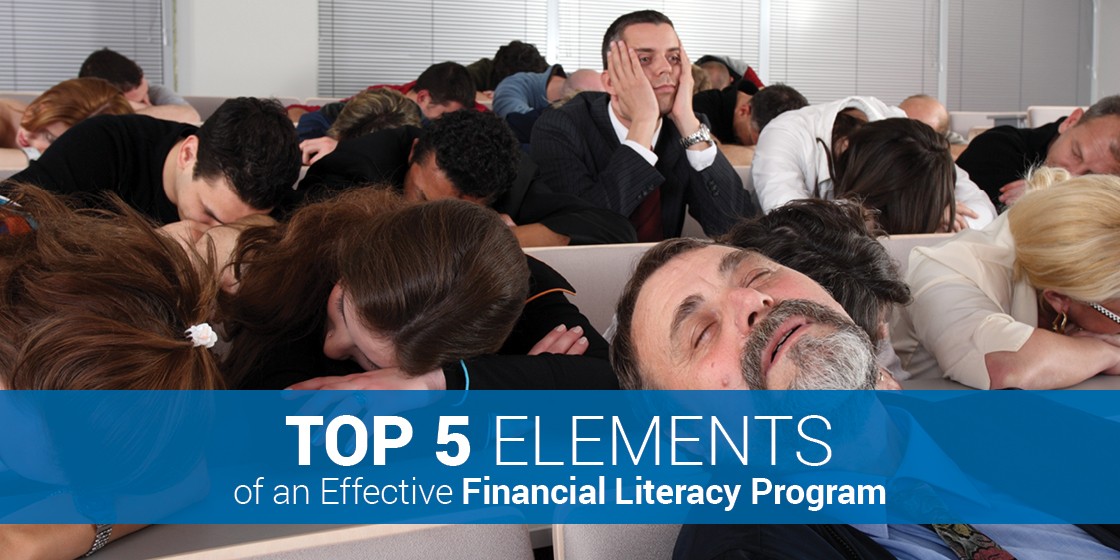Top 5 Elements of an Effective Financial Literacy Program

Credit unions have traditionally been proactive in providing financial education to their members. These efforts not only help improve financial literacy in the fundamental sense, but can also help change behavior – driving positive, real-world outcomes for those who participate.
However, the financial landscape is growing more complex and challenging. Financial wellness programs now need to consider issues like data security, mobile accessibility, online banking, etc.
Educational efforts are being further complicated by demographic changes. Younger millennial audiences bring their own unique attitudes and expectations to the table, which can place significant new demands on those who design and run such programs to make them “current”.
To address these issues, financial literacy trainers are seeking to move beyond PowerPoint-driven lectures and into educational programs that successfully blend proven instructional principles with new techniques and technologies.
If you’re looking to improve your financial literacy program, here are the top 5 areas you should consider.
- Focus on the Audience
- Balance Theory & Application
- Personalize Your Content
- Offer Multiple Consumption Opportunities
- Drive Active, Positive Engagement
1. Focus on the Audience
In an era of increasing personalization, we can no longer expect financial literacy programs based on generic one-size-fits-all curricula to meet the varied needs of a diverse set of audiences. Further, as a result of an increasingly digitalized lifestyle, most people generally lose concentration after eight seconds. Therefore, presentation content must be compelling.
Towards that goal, multiple programs that are focused on specific audiences and their specific learning objectives will be effective and engaging.
These can vary across several parameters. The first grouping will likely be demographic in nature, basing your content on the target audience’s age and life experience. For instance, students who are managing loans vs. seniors who are managing retirement portfolios. Each will have very different expectations for a credit union financial literacy program.
You can also present selected content based on audience knowledge and expertise. There will be members, regardless of age or background, who need a foundational program focused on the basics of financial wellness. Likewise, there will be more experienced members who are seeking advanced techniques to further improve their financial situation.
So, the first step in creating a more effective financial literacy program is to create different options for engaging relevant content, organized around these different audience-based groupings. Just as important is how you present and name these packages. Be straightforward and descriptive. This will help audiences self-select the appropriate content, leading to better results and more satisfied members.
2. Balance Theory & Application
As professional trainers, we know there are critical financial concepts that underlie any sound credit union financial literacy program – the long-term power of compounding interest, understanding when and how to leverage debt, the meaning behind a credit score, the inverse relationship between principal and interest in an amortization table, and so on.
However, these higher-level concepts must be tied to real-world applications, real-world objectives, and real-world examples to make them relatable. Otherwise, they will remain purely theoretical in the minds of your students, with no clear link as to how to put them into practice.
For instance, if you are discussing the shifting weights between principle and interest in an amortization table, tie this concept to a student loan or mortgage payment (depending on the demographics of your audience). Show how this ratio changes over time and demonstrate how much of your member’s money is going to one versus the other to help bring the concept to life.
Also, don’t hesitate to include challenging topics. People are engaging with a financial literacy program because they are craving knowledge. While it is nice to talk about a growing retirement nest egg, the reality is that many of those seeking financial wellness have encountered (or may be soon running into) some serious challenges and obstacles.
Case in point: The flip side of good credit is the issue of debt, and more specifically the issue of missed payments that may hurt a credit score. Members need to know the difference between loan defaults, delinquencies, deferments, and forbearance, as these are all components of debt management and overall financial wellness. So, these issues need to be addressed, at least at a basic level.
3. Personalize Your Content
Another great way to improve outcomes for your members is to tie different areas of your financial wellness program to specific member objectives. And the easiest way to do this is with personalized exercises and applications.
Managing a budget, applying for a mortgage, car, and other loan payments, saving for a trip or other significant purchase – these are all real-world examples that can be integrated directly into the appropriate sections of your training program.
Possible options include demonstrating scenarios and outcomes for the entire class, or setting aside some one-on-one working time, where individuals can go through these exercises personally and privately.
In the past, these types of personal exercises involved printed workbooks and paper hand-outs. While these tools may still have their place, depending upon your audience, today’s era of interactive digital tools and calculators are widely accessible and can be used in both online programs and local seminars.
Digital programs have the added advantage of being “bookmarkable” destinations on your website that members can visit even after the program ends. By doing so, it can enhance your credit union’s brand recognition, website traffic (what other services can you offer them?) and member loyalty.
4. Offer Multiple Consumption Opportunities
It is widely accepted that different individuals consume and process information in different ways. This realization can also be broadly generalized demographically, with a majority of millennials preferring to consume their content via video, while most baby boomers still prefer to read written text.
To reach your target audience in the form they most readily embrace, and to help ensure more positive outcomes for more members, it is recommended that content is delivered through a variety of different media across a variety of different consumption channels. While websites such as the National Credit Union Administration (NCUA) offer comprehensive and overarching programs, more specific information is available through ConServe’s Financial Literacy Resources.
Credit unions with the most successful financial wellness programs make their topics available via articles, webinars, and gamification games and videos. Then they deliver these various pieces of content via online on-demand avenues, as well as with in-person training sessions and seminars.
Recognizing the challenge of being all things to all people, pilot programs with detailed reporting of participation and engagement can help identify the best media vehicles and delivery channels for your priority audiences.
Adopting a long-term perspective will enable you to fill out your content and channels, while establishing a goal of running a “maintain and refine” program versus building everything all at once.
5. Drive Active, Positive Engagement
Traditional content-heavy slide presentations filled with rows of bullet points are obsolete and fail to engage an audience. Instead, strive to combine dynamic and relevant subject matter with varied and exciting modes of delivery to keep audiences participating and interested.
It starts with your content. This needs to be dynamic on every level. Sounds, graphics, imagery, and video should all be leveraged over the course of the program. Not only will these stimulate the senses and keep participants engaged, but captivating visuals have been shown to help improve reception and retention, which will help drive better outcomes.
When possible, an expert facilitator and/or subject matter expert should be brought in to run the training – someone who knows how to keep participants engaged, solicit questions, and maintain a high level of energy and positivity. Audiences will always prefer a personable, well-prepared host versus a lackluster subject matter expert who falls flat when it comes to presentation (especially when they’re prepared to elevate important questions).
In addition to following up on personal questions, automated post-event campaigns with supporting materials and relevant communications will ingrain the importance of your program. These can help ensure ongoing awareness and engagement, with the financial wellness program and with your credit union.
Conclusion
Credit unions that establish financial literacy programs for their members and support financial wellness efforts within their communities simultaneously establish a relationship of trust with both prospects and stakeholders.
However, even the best, most important information will fall on deaf ears if it is not relevant and valuable. It must be organized, prepared, and presented in a way that lends itself to the appropriate target audience, and is delivered when and how they want it.
To ensure the best results of a targeted financial wellness program, it is critical that a comprehensive approach, taking into account the many different components of financial literacy, be designed to deliver the content your audiences need to manage their challenges while empowering them to achieve their goals.
By becoming a trusted advisor throughout life’s biggest financial milestones, credit unions can position themselves as a long-term partner for their members. A partner who will work with them and their families as they transition through the many different phases and chapters of their lives.
After all, isn’t that the ultimate mission of a credit union?

